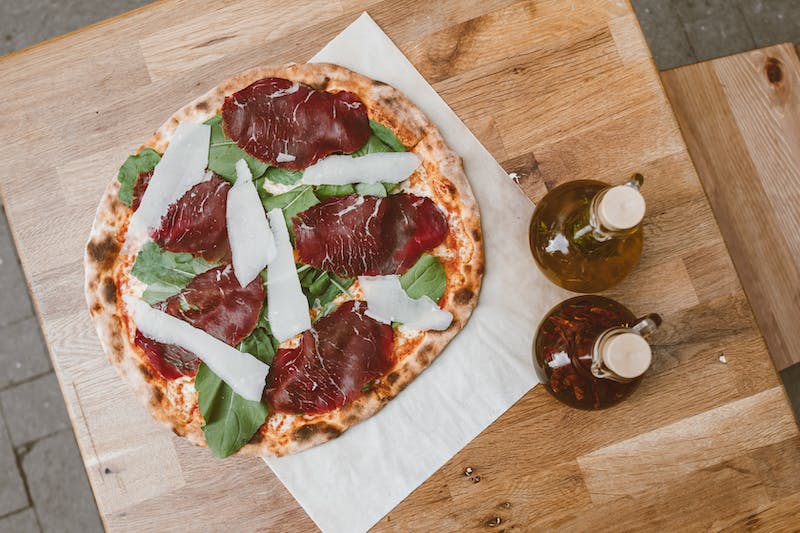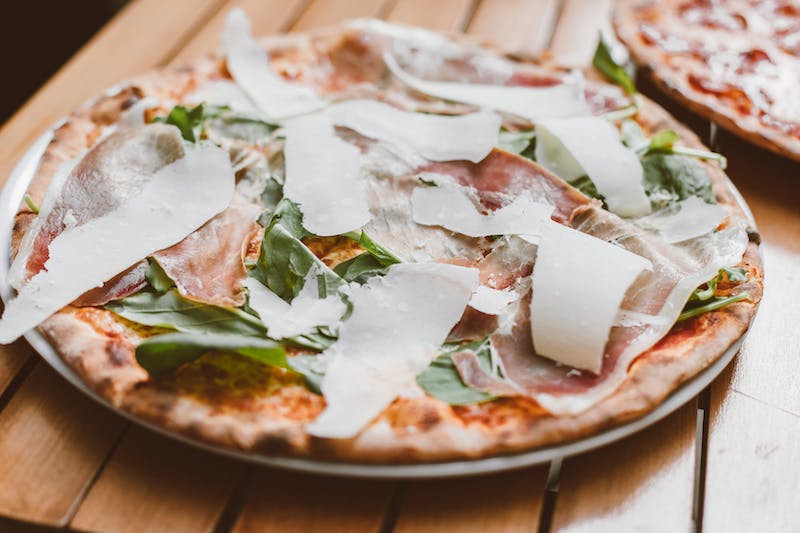Dive into the delicious world of pizza with our expertly crafted guide, “Best Pizza Topping Combos.” This culinary exploration is your ticket to mastering the art of perfect pizza creation. Every slice is a canvas, and the toppings are your palette; understanding how to combine them is essential for achieving that mouthwatering masterpiece that pizza lovers strive for.
Whether you’re looking to recreate the ambiance of a cozy Italian pizzeria at home or simply want to impress your friends with your pizza prowess, our guide is packed with valuable insights. We reveal why certain toppings are a match made in heaven, how to select quality ingredients, and what combinations will satisfy even the most diverse palates.
Mastering Pizza Toppings
Pizza is so much more than bread and sauce. The toppings are key for creating a balanced flavor and texture experience. Let’s start our pizza journey by exploring topping combinations from tried-and-true to unexpected.
Best Pizza Topping Combos
Here are some popular and delicious pizza topping combinations that you can try:
- Margherita Pizza
- Tomato sauce, fresh mozzarella cheese, and basil. This classic combination reflects a time when pizzas were simple and delicious.
- Pepperoni and Sausage
- Tomato sauce, mozzarella cheese, pepperoni, and sausage. The spicy pepperoni combined with meaty sausage pellets creates an authentic and satisfying taste.
- BBQ Chicken
- BBQ sauce, mozzarella cheese, grilled chicken, red onions, and cilantro. This pizza offers a sweet, smoky, and tangy flavor with a fresh twist from cilantro.
- Hawaiian Pizza
- Tomato sauce, mozzarella cheese, ham, and controversially pineapple. The sweet and savory combination of ham and pineapple is a unique choice that some love and others debate.
- White Pizza
- Olive oil, garlic, ricotta cheese, and mozzarella cheese. This pizza lets the creaminess of ricotta cheese shine through without tomato sauce, enhanced by the mild flavor of mozzarella and a touch of garlic.
- Buffalo Chicken Pizza
- Buffalo sauce, mozzarella cheese, chicken, blue cheese crumbles, and red onions. Perfect for those who enjoy bold and spicy flavors with a hint of blue cheese to balance the heat.
- Meat Lovers Pizza
- Tomato sauce, mozzarella cheese, pepperoni, sausage, bacon, and ham. A protein-packed delight for meat enthusiasts that is hearty and satisfying.
- Supreme Pizza
- Tomato sauce, mozzarella cheese, pepperoni, sausage, bell peppers, onions, and mushrooms. A crowd-pleaser with a variety of toppings that cater to different tastes.
- Taco Pizza
- Tomato sauce, mozzarella cheese, ground beef, lettuce, tomatoes, and sour cream. Inspired by the flavors of a taco with a pizza twist for a unique dining experience.
- BLT Pizza
- Spread mayonnaise onto your crust and top it with Monterey jack cheese, bacon, lettuce, and tomatoes for a delicious twist on the classic BLT sandwich.
These combinations offer a range of flavors from traditional to more adventurous options to suit various preferences.
Classic Combinations for Every Palate
Here are some timeless topping combos perfect for pleasing a crowd:
- Pepperoni and mushroom – Spicy, earthy, and super savory.
- Sausage and peppers – The classic pairing highlights sweet and spicy sausage with vibrant roasted peppers.
- Extra cheese and tomato – You really can’t go wrong with melted cheese and bright, acidic tomatoes.
- Pesto and chicken – Nutty pesto complements lean protein for a fresh and filling pizza.
- Carne – Loaded up with pepperoni, sausage, ham, beef, and bacon for the ultimate meat lover’s pizza.
Dietary Considerations in Toppings
With creative substitutions, pizza can work for any diet:
- Gluten-Free: Use a gluten-free crust and avoid sew-on meats like pepperoni or sausage which may contain gluten fillers. Stick to whole, naturally gluten-free toppings like veggies, cheese, and proteins like chicken or shrimp.
- Vegan: Skip the cheese and opt for vegan versions or leave it off altogether. Pile on veggies, mushrooms, plant-based proteins like chickpeas or tofu, and drizzle with olive oil instead of dairy-based sauces.
- Low-Carb: Choosing non-starchy veggies as toppings and limiting higher carb options like fruit can create a more low-carb pizza. You can also opt for a cauliflower crust over traditional dough.
- Nut Allergies: Avoid pesto and pine nuts or opt for walnut or sunflower seed pesto variations. Skip ground cashews or almonds as alternative cheese or sauce bases.
- Soy Allergies: Use real cheese instead of soy-based cheese alternatives. Avoid soy-based meat substitutes like grounds or sausage.
Balancing Flavors and Nutrition
Some guidelines for building balanced, craveable pizzas:
- Include a sauce for moisture and flavor foundation. Tomato or pesto are classic choices.
- Use cheese for creaminess, texture, fat, and protein. Mix it up with blends of mozzarella, Parmesan, feta, etc.
- Feature 1-2 proteins like pepperoni, sausage, chicken or plant-based options. This gives satisfying savory flavor and protein.
- Load up on veggies for fiber, vitamins, and bright colors and flavors.
- Add textural toppings like mushrooms or peppers. Try roasting veggies first for caramelized flavor.
- Finish with herbs or spices like oregano, red pepper flakes, or basil for freshness.
- Drizzle with olive oil or a balsamic glaze for healthy fat and tang.
Pizza Making Essentials
While creative toppings make the pizza, the foundation of dough, sauce, and cheese are what hold it all together. Let’s explore how to craft and layer these elements like a pro.
Crafting the Perfect Dough
The dough is the sturdy, chewy, crispy canvas that makes pizza, well, pizza. Here’s how to make dough worth bragging about:
Traditional and Alternative Pizza Dough Recipes
Read on to learn more : What is NY Style Pizza? The Story & Quick Guide Inside
Basic pizza dough features just a few simple ingredients:
- Flour – typically all-purpose or bread flour
- Water
- Yeast – active dry or instant
- Salt
- Olive oil (optional)
You can find myriad easy traditional pizza dough recipes online for a starting point. Most take just 5-10 minutes of active prep.
The Science of Dough Fermentation Explained
The fermentation process is what takes your dough from shaggy blob to perfect pillowy pizza base. Here’s how it works:
- Yeast eats sugar – Yeast are tiny living organisms that consume sugars and convert them into carbon dioxide gas and ethanol.
- Carbon dioxide causes rise – The gas gets trapped in the dough, causing it to inflate. This is known as leavening.
- Time develops flavor – Allowing the yeast to slowly work over several hours develops complex flavors and gluten structure.
- Longer fermentation = bigger bubbles and chewier crust – The bubbles expand and the gluten relaxes over time.
The Art of Pizza Sauce
You can keep it simple or get creative with your own signature sauce.
- Traditional red sauce features tomatoes, olive oil, garlic, spices, and fresh herbs. Simmer canned crushed tomatoes to reduce liquid and concentrate flavor.
- White sauces use creamy ingredients like ricotta, mozzarella, parmesan, garlic, and olive oil. Add spinach or arugula for a fresh twist.
- Pesto makes a bold, herby green sauce. Use basil, pine nuts, garlic, olive oil, and parmesan.
- Barbecue sauce is an easy swap for a sweet and tangy pizza.
- Alfredo can sub for red sauce when you’re craving extra decadence and garlic.
Layering Like a Pro
Once your dough, sauce, and toppings are prepped, it’s time for assembly. Use these techniques for pizza perfection:
- Stretch and top dough on a floured surface to desired size and shape.
- Spread sauce first leaving about 1⁄2 inch border to prevent burning.
- Grate, slice, or sprinkle cheese so it covers sauce fully. This prevents the dough from becoming soggy.
- Layer meats and veggies by priority. Place ingredients that release moisture like tomatoes on top.
- Finish with herbs or spices for final seasoning.
- Drizzle olive oil around the edges for and added boost of flavor.
If you’re feeling confident, try tossing and spinning the dough for an impressive presentation.
Cooking, Preservation, and Reheating

You’ve built the perfect pizza – now it’s time to take it from dough to done. We’ll cover how to cook pizzas to perfection along with storing and reheating leftovers safely.
Baking the Perfect Pizza
Pizza can be cooked in conventional ovens, on the grill, or for the crispiest crust, with a pizza stone or steel.
- Oven method: Preheat oven as high as possible, 500°F or higher. Place pizza directly on rack or pan for 7-12 minutes until crust is crisp and cheese is melted. Use a pizza peel to easily slide pizza onto the hot oven rack.
- Grilling method: Grill over direct high heat for 2-3 minutes per side. Close the lid to melt cheese. Watch closely to avoid burning.
- Pizza stone/steel method: Preheat a pizza stone or steel for at least 30 minutes at highest oven temp. The stone crisps the crust beautifully. Just a few minutes of baking and the crust will be perfectly charred.
Storing Leftover Pizza
Here are the best ways to store pizza:
- Allow pizza to cool completely before storing to prevent condensation and sogginess.
- For short term (1-2 days), store pizza covered in the fridge. The crust may soften slightly.
- For longer term, wrap tightly in plastic wrap then foil and freeze for 2-3 months. Thaw in fridge before reheating.
Reheating Tips
Revive leftover pizza to nearly fresh-baked quality:
- Preheat oven to 400°F. Place pizza directly on the oven rack or a pizza stone/steel.
- Crisp the crust for 3-5 minutes. Toppings don’t need long to heat through.
- Use a toaster oven for single slice reheating. 2-3 minutes at 400°F does the trick.
- Microwave if you’re in a pinch. 30-60 seconds heats without making the crust soggy. Add a cup of water with pizza to steam it.
- For grill reheating, heat grill to high and toast just until cheese melts and crust is crisp, 1-2 minutes per side.
Pizza and Health
With some simple tips, you can enjoy this cheesy treat while still getting good nutrition.
Making Healthier Pizza Choices
- Pick whole grain crust – Choose whole wheat or alternative grain recipes for an extra fiber boost.
- Load up the veggies – Focus on veggie toppings like spinach, onions, peppers, mushrooms. Limit fatty meats and cheeses.
- Go lean on protein – Chicken, shrimp, turkey pepperoni, lean ham will cut calories and fat versus pepperoni and sausage.
- Use sparing cheese – A little cheese goes a long way. Limit to 1-2 ounces per pizza.
- Drizzle with oil – Olive or avocado oil give healthy fats instead of artery-clogging saturated fat from meats and excessive cheese.
- Make it mini – Make personal sized pizzas for easy portion control.
- Mix in cauliflower – Add riced cauliflower to pizza dough for fewer carbs and calories.
Understanding Pizza’s Nutritional Content
To make informed choices, let’s break down typical pizza nutrition stats for a medium slice:
- Calories – 250-400 depending on crust and toppings
- Carbs – 30-60g mostly coming from crust
- Protein 10-25g from cheese, meats, and thickness of crust
- Fat 5-15g from cheese, oil, meats
- Sodium 600-1000mg from cheese, sauce, cured meats
Read on to learn more : How Much Pizza For 10 People? Calculate The Perfect Pizza
As you can see traditional pizza is high in carbs, sodium and can pack in calories and fat if portions aren’t controlled. Choosing healthier ingredients can cut the fat and sodium while keeping pizza as a reasonable option for your diet.
A Guide to Calories, Macros, and Portion Control
To maintain healthy pizza habits, watch your portions and balance it in your overall diet. Here are some serving tips:
- Stick to 1-2 slices depending on your calorie needs
- Add side salad instead of excess carbs from garlic bread, fries, etc. This helps fill you up with fewer calories
- Alternate protein-focused meals before and after pizza night to balance macros
- Consider a medium slice around 300 calories as a ballpark estimate for meal planning
- Eat pizza only occasionally if you are closely monitoring carbs
The key is enjoying pizza mindfully rather than mindlessly overindulging. Having the occasional pizza in moderate portions can absolutely be part of a balanced diet.
Family and Safety

Safely get the kids involved in the kitchen and make memories together.
Kid-Friendly Pizza Making
Pizza prep is a perfect way to teach little ones kitchen skills and fuel their creativity.
- Have kids help stretch or toss dough into shape (with heavily floured hands)
- Let them add sauce and sprinkle cheese and toppings.
- Challenge kids to invent their own flavor combinations.
- Place ingredients in bowls and set up a DIY pizza bar.
- Take advantage of play kitchen sets to mimic pizza making.
- For picky eaters, keep one half of the pie plain cheese.
With supervision, kids 3+ can take part in pizza preparations and build culinary confidence.
Pizza Topping Safety
When cooking with kids, be mindful of choking hazards and proper handling:
- Slice ingredients into small pieces appropriate for kids’ ages. Grapes, olives, meat, and hard veggies are common choking hazards.
- Monitor use of ingredients like peppers or onions that can cause skin or eye irritation during prep.
- Wash all produce thoroughly before use.
- Follow safe meat handling. Wash hands after handling and cook meats to safe internal temperatures.
- Check for nut allergies. Limit use of nuts in pesto, sauces or as toppings with young kids.
Have fun making memories in the kitchen while also setting kids up for a lifetime of stellar pizza making.
Beyond the Pizza
A homemade pizza is a delicious centerpiece for good times with family and friends. Read on for tips on hosting pizza parties and creatively using up leftovers.
Hosting a Pizza Party
A DIY pizza party lets guests customize their perfect pie:
- Set up stations with crusts, sauce, cheeses, and prepped toppings. Provide recipes so guests can recreate the sauces and dough at home.
- Supply aprons and pizza tools like peel, cutter, and ample flour. Bonus points for chef’s hats.
- Keep things organized with labeled ingredients and toppings in separate containers.
- Make it potluck by having guests bring favorite sauces, homemade doughs, drinks, or desserts.
- Embrace creativity and customization with a wide array of meat, veggie, and even sweet topping options.
- Have takeaway containers available so guests can bring home slices or leftover ingredients.
Creative Uses for Leftover Ingredients
Leftover ingredients from your pizza party shouldn’t go to waste. Repurpose them into tasty new dishes:
- Extra dough = breadsticks, cinnamon rolls, or pizza bombs (fried dough stuffed with cheese and pizza toppings)
- Leftover sauce = Simmer with cream for pasta, use in sandwiches or top meats and veggies
- Veggie toppings = Omelets, stir frys, sandwiches, salads
- Cheese = Grilled cheese, nachos, mac and cheese, cheese crisps
- Pepperoni or sausage = Breakfast sandwiches, pasta, soup
With a little creativity, you can reinvent leftovers into fresh meals again and again.

Chef John Sebastian has been cooking up a storm at his simple place for years. Offering a variety of international foods, Chef John Sebastian has something for everyone- and he makes it all look easy!
He’s been featured in various food magazines and cooking shows, and his restaurant has become a local favorite in the community. When he’s not in the kitchen, Chef John Sebastian enjoys spending time with his family.









